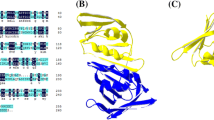Abstract
Objectives
To analyze the mechanisms underlying the impact of recombinant Autographa californica multicapsid nucleopolyhedrovirus (AcMNPV)-mediated BmK IT expression on the function of baculovirus GP64 envelope fusion protein and progeny virus production.
Results
Viral propagation assay indicated that overexpression GP64 could promote replication of AcMNPV. AcMNPV-mediated expression of BmK IT also promoted replication of AcMNPV. Immunofluorescence analysis showed BmK IT, which was regulated by very early promoter IE1 in AcMNPV, could make the GP64 protein move to the cytomembrane soon after transfection. BmK IT, which is regulated by P10 protein promoter (P10) and polyhedrosis promoter (PH), could promote the expression of GP64.
Conclusion
BmK IT, regulated by very early promoter IE1, P10 protein promoter (P10) and PH, accelerated the expression of GP64 protein, promoted its early cytomembrane localization and then triggered virus budding and progeny virus production.




Similar content being viewed by others
References
Ali MP, Kato T, Park EY (2015) Improved insecticidal activity of a recombinant baculovirus expressing spider venom cyto-insectotoxin. Appl Microbiol Biotechnol 99:10261–10269
Blissard GW, Rohrmann GF (1989) Location, sequence, transcriptional mapping, and temporal expression of the gp64 envelope glycoprotein gene of the Orgyia pseudotsugata multicapsid nuclear polyhedrosis virus. Virology 170:537–555
Dong S, Blissard GW (2012) Functional analysis of the Autographa californica multiple nucleopolyhedrovirus GP64 terminal fusion loops and interactions with membranes. J Virol 86:9617–9628
Fan XJ, Zheng B, Fu YJ, Sun Y, Liang AH (2008) Baculovirus mediated expression of a Chinese scorpion neurotoxin improves insecticidal efficacy. Chin Sci Bull 53:1855–1860
Fu YJ, Zhao J, Liang AH, Hu FY (2015) AcMNPV-mediated expression of BmK IT promotes the apoptosis of Sf9 cells and replication of AcMNPV. Acta Physiolog Sinica 67:305–311
Gurevitz M, Froy O, Zilberberg N, Turkov M, Strugatsky D, Gershburg E, Lee D, Adams ME, Tugarinov V, Anglister J, Shaanan B, Loret E, Stankiewicz M, Pelhate M, Gordon D, Chejanovsky N (1998) Sodium channel modifiers from scorpion venom: structure-activity relationship, mode of action and application. Toxicon 36:1671–1682
Hefferon K, Oomens A, Monsma S, Finnerty C, Blissard GW (1999) Host cell receptor binding by baculovirus GP64 and kinetics of virion entry. Virology 258:455–468
Lazarev VN, Polin NF, Shkarupeta MM, Kostrjukova ES, Vassilevski AA, Kozlov SA, Grishin EV, Govorun VM (2011) Spider venom peptides for gene therapy of Chlamydia infection. Antimicrob Agents Chemother 55:5367–5369
Li Z, Blissard GW (2009) The Autographa californica multicapsid nucleopolyhedrovirus (AcMNPV) GP64 protein: analysis of transmembrane(TM) domain length and sequence requirements. J Virol 83:4447–4461
Li Z, Blissard GW (2010) Baculovirus GP64 disulfide bonds: the intermolecular disulfide bond of AcMNPV GP64 is not essential for membrane fusion and virion budding. J Virol 84:8584–8589
Li Z, Blissard GW (2011) The AcMNPV GP64 protein: roles of histidine residues in triggering membrane fusion and fusion pore expansion. J Virol 85:12492–12504
Lung O, Westenberg M, Vlak JM, Zuidema D, Blissard GW (2002) Pseudotyping Autographa californica multicapsid nucleopolyhedrovirus (AcMNPV): F proteins from group II NPVs are functionally analogous to AcMNPV GP64. J Virol 76:5729–5736
Mohammad M, Mazhar H, Leila M, Sassan A (2015) The baculovirus antiapoptotic p35 protein functions as an inhibitor of the host RNA interference antiviral response. J Virol 89:8182–8192
Oomens AG, Blissard GW (1999) Requirement for GP64 to drive efficient budding of Autographa californica multicapsid Nucleopolyhedrovirus. Virology 254:297–314
Qian LY, Blissard GW, Liu TX, Zhao FL (2015) Autographa californica multiple nucleopolyhedrovirus GP64 protein: analysis of domain I and V amino acid interactions and membrane fusion activity. Virology 488:259–270
Shim HJ, Cho JY, Wang Y, Tao XY, Li Q (2013) NeuroBactrus, a novel, highly effective, and environmentally friendly recombinant baculovirus insecticide. Appl Environ Microbiol 79:141–149
Vassilevski AA, Kozlov SA, Samsonova OA, Egorova NS, Karpunin DV, Pluzhninkov KA, Feofanov AV, Grishin EV (2008) Cytoinsectotoxins, a novel class of cytolytic and insecticidal peptides from siper venom. Biochem J 411:687–696
Wang ML, Tan Y (2008) The F-Like protein Ac23 enhances the infectivity of the budded virus of gp64-null Autographa californica multinucleocapsid nucleopolyhedrovirus pseudotyped with baculovirus envelope fusion protein F. J Virol 82:9800–9804
Whitford M, Stewart S, Kuzio J, Faulkner P (1989) Identification and sequence analysis of a gene encoding gp67, an abundant envelope glycoprotein of the baculovirus Autographa californica nuclear polyhedrosis virus. J Virol 63:1393–1399
Wu CX, Wang S (2012) A pH-sensitive heparin-binding sequence from baculovirus gp64 protein is important for binding to mammalian cells but not to Sf9 insect cells. J Virol 86:484–491
Zhou J, Blissard GW (2008a) Identification of a GP64 subdomain involved in receptor binding by budded virions of the baculovirus AcMNPV. J Virol 82:4449–4460
Zhou J, Blissard GW (2008b) Display of heterologous proteins on gp64null baculovirus virions and enhanced budding mediated by a VSV G-stem construct. J Virol 82:1368–1377
Acknowledgments
This project was supported by grants from ‘National Natural Science Foundation of China (No.31272100, 31372199 and 31400765)’, ‘Natural Science Foundation of Shanxi Province (No.2014011038-1)’, and ‘the Program for the Top Young Academic Leaders of Higher Learning Institutions of Shanxi’.
Author information
Authors and Affiliations
Corresponding author
Rights and permissions
About this article
Cite this article
Fu, Y., Miao, Y., Zheng, S. et al. AcMNPV-BmK IT improves the progeny virus production via baculovirus GP64 envelope fusion protein. Biotechnol Lett 38, 1673–1681 (2016). https://doi.org/10.1007/s10529-016-2146-8
Received:
Accepted:
Published:
Issue Date:
DOI: https://doi.org/10.1007/s10529-016-2146-8




